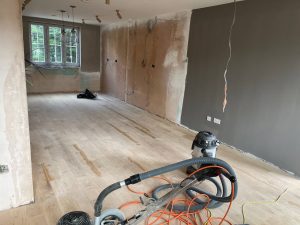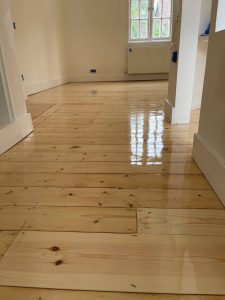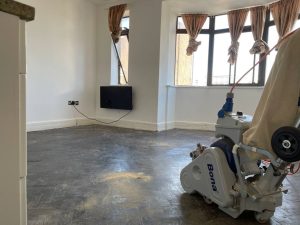
Floor sanding is a fantastic way to rejuvenate your wooden floors, giving them a fresh, polished look. However, it’s a task that requires precision and care. Many homeowners in London make common mistakes during the sanding process, which can lead to unsatisfactory results or even damage to the floors. Here are some common floor sanding mistakes and how to avoid them.
- Skipping the Prep Work

Mistake:
- Not thoroughly preparing the room before sanding can result in damage to your floors or equipment. This includes failing to remove all furniture, nails, and staples.
How to Avoid:
- Clear the Room: Remove all furniture and rugs. Ensure the room is entirely empty to provide a clear working space.
- Inspect and Repair: Check for and remove any nails, staples, or other debris that could damage the sander. Repair any loose floorboards and fill gaps or cracks with wood filler.
- Using the Wrong Sandpaper Grit
Mistake:
- Starting with a grit that is too fine or skipping grits can lead to uneven sanding and poor results.
How to Avoid:
- Start Coarse: Begin with a coarse grit sandpaper (40-60 grit) to remove old finishes and deep scratches. Progress through medium (80 grit) to fine (120 grit) sandpaper for a smooth finish.
- Follow a Sequence: Don’t skip grits. Each step should smooth out the scratches from the previous grit.
- Not Sanding Evenly
Mistake:
- Sanding unevenly or staying too long in one spot can create dips and gouges in the floor.
How to Avoid:
- Keep Moving: Always keep the sander moving at a steady pace. Never stop in one spot while the sander is running.
- Sand with the Grain: Move the sander in the direction of the wood grain to avoid creating cross-grain scratches.
- Ignoring the Edges
Mistake:
- Neglecting the edges of the room can leave an unsightly border that doesn’t match the rest of the floor.
How to Avoid:
- Use an Edge Sander: Equip yourself with an edge sander to reach areas that the drum sander cannot.
- Consistent Sanding: Ensure the edges are sanded with the same grit sequence as the main floor area for a consistent look.
- Poor Dust Management
Mistake:
- Not managing dust can lead to a messy work environment and imperfections in the finish.
How to Avoid:
- Use Dust Collection: Attach a dust collection system to your sander to minimise airborne dust.
- Frequent Cleaning: Regularly vacuum the floor and surrounding area during the sanding process to keep the workspace clean.
- Applying Finish Too Soon
Mistake:
- Applying the finish before the floor is completely clean and free of dust can result in a rough, uneven surface.
How to Avoid:
- Clean Thoroughly: After sanding, vacuum and wipe down the entire floor with a tack cloth to remove all dust.
- Allow Drying Time: Ensure the floor is completely dry and dust-free before applying any finish.
- Choosing the Wrong Finish
Mistake:
- Selecting a finish that is not suitable for your floor type or your home’s environment can lead to premature wear or an undesirable appearance.
How to Avoid:
- Research Finishes: Consider the type of wood and the amount of traffic the floor will endure. Water-based polyurethanes are great for a clear, durable finish, while oil-based polyurethanes provide a warm, amber tone.
- Test First: Test the finish on a small, inconspicuous area before applying it to the entire floor to ensure it meets your expectations.
Conclusion
Avoiding these common floor sanding mistakes can make a significant difference in the quality and longevity of your finished floors. By taking the time to properly prepare, using the right tools and techniques, and applying the appropriate finish, you can achieve professional-looking results that enhance the beauty of your London home.
Investing in the correct approach not only saves you time and money but also ensures that your floors remain a stunning feature for years to come. Remember, if you’re unsure about any part of the process, consulting with or hiring a professional floor sanding service can help you achieve the best results.








The Impact of Floor Sanding on Home Value
The Impact of Floor Sanding on Home Value Enhance Your London Home’s Value with[Read more...]
The Benefits of Floor Sanding for Open House Showings
London Property Tips Home About Contact The Benefits of Floor Sanding for Open House[Read more...]
Innovations in Floor Sanding Technology
The field of floor sanding has seen significant advancements in recent years, making the process[Read more...]
How to Prepare for Floor Sanding with Pets in the House
How to Prepare for Floor Sanding with Pets in the House Preparing for floor[Read more...]
The Importance of Grain Direction in Floor Sanding
The Importance of Grain Direction in Floor Sanding When it comes to floor sanding,[Read more...]
The Lifespan of Sanded Floors: What to Expect
Sanded floors can significantly enhance the beauty and value of your home, especially in a[Read more...]
floorboard replacement
[Read more...]
The Impact of Seasonal Changes on Sanded Floors
The Impact of Seasonal Changes on Sanded Floors Protect and maintain your wooden floors[Read more...]
The Best Floor Sanding Practices for Older Homes
The Best Floor Sanding Practices for Older Homes Older homes in London often feature beautiful[Read more...]
The Difference Between Water-Based and Oil-Based Finishes
The Difference Between Water-Based and Oil-Based Finishes Choosing the Best Finish for Your Wooden[Read more...]